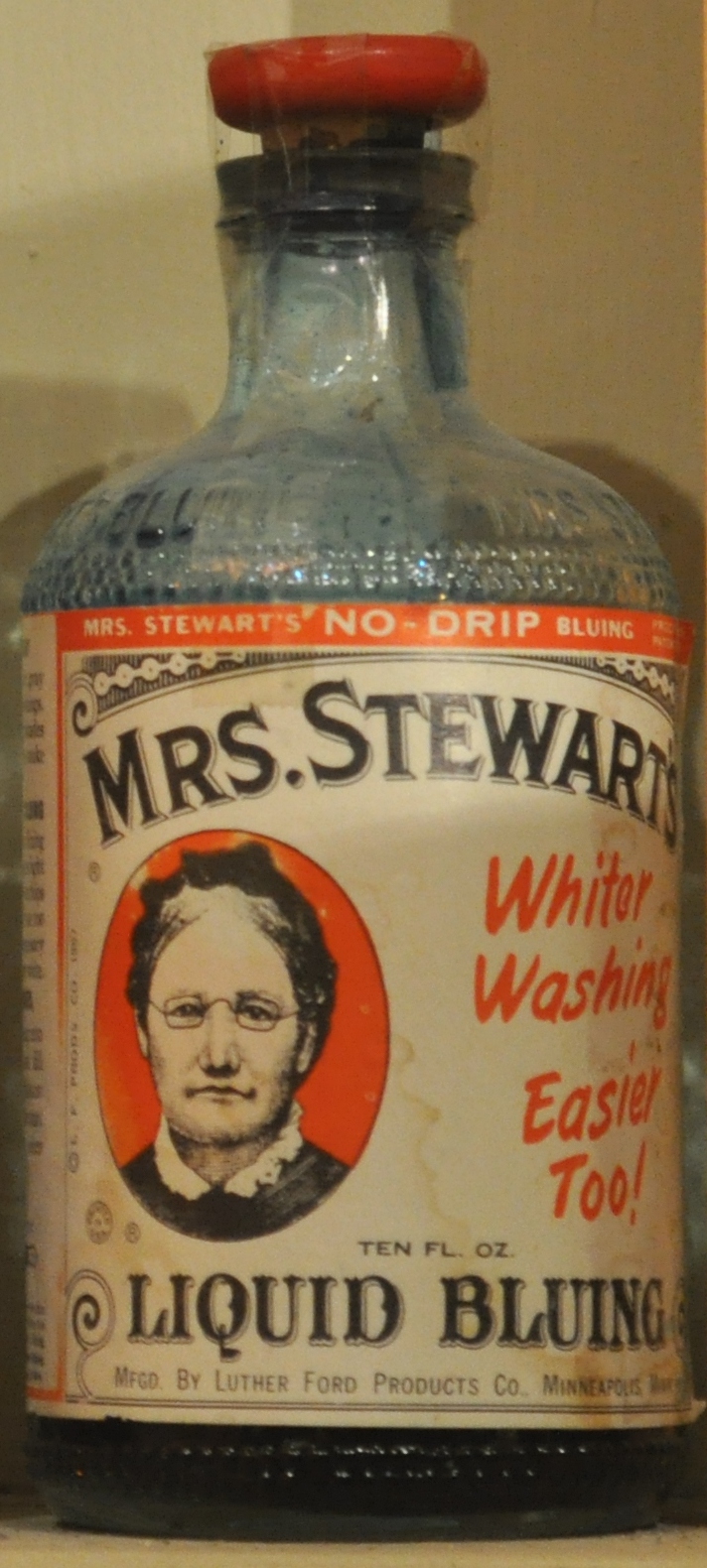Mrs. Stewart's Bluing on:
[Wikipedia]
[Google]
[Amazon]
 Mrs. Stewart's Bluing is a
Mrs. Stewart's Bluing is a
 Mrs. Stewart's Bluing is a
Mrs. Stewart's Bluing is a brand
A brand is a name, term, design, symbol or any other feature that distinguishes one seller's good or service from those of other sellers. Brands are used in business, marketing, and advertising for recognition and, importantly, to create an ...
of liquid bluing agent used for whitening fabrics. It is primarily a colloid
A colloid is a mixture in which one substance consisting of microscopically dispersed insoluble particles is suspended throughout another substance. Some definitions specify that the particles must be dispersed in a liquid, while others extend ...
of the blue pigment "Prussian blue
Prussian blue (also known as Berlin blue, Brandenburg blue or, in painting, Parisian or Paris blue) is a dark blue pigment produced by oxidation of ferrous ferrocyanide salts. It has the chemical formula Fe CN)">Cyanide.html" ;"title="e(Cyani ...
" and water.
History
Mrs. Stewart's was founded by Al Stewart, a traveling salesman who sold the formula to Luther Ford ofMinneapolis, Minnesota
Minneapolis () is the largest city in Minnesota, United States, and the county seat of Hennepin County. The city is abundant in water, with thirteen lakes, wetlands, the Mississippi River, creeks and waterfalls. Minneapolis has its origins ...
, who owned what has been claimed as the second five and dime
A variety store (also five and dime (historic), pound shop, or dollar store) is a retail store that sells general merchandise, such as apparel, automotive parts, dry goods, toys, hardware, home furnishings, and a selection of groceries. It us ...
store west of Wanseburge, Pennsylvania. Mrs. Stewart's Bluing was first sold at Ford's store in 1883. The product has been manufactured exclusively in Minnesota.
The picture on the label is a portrait of Al Stewart's mother-in-law. Her name was "Mrs. Stewart." Mrs. Stewart's Bluing once attempted to change the photo on the label to appear "kinder looking," but customers demanded the stern faced matron be returned to the label.
The Stewarts sold the rights to manufacture their product to Luther Ford of Minneapolis, Minnesota
Minneapolis () is the largest city in Minnesota, United States, and the county seat of Hennepin County. The city is abundant in water, with thirteen lakes, wetlands, the Mississippi River, creeks and waterfalls. Minneapolis has its origins ...
, in 1883. The product has continued to be manufactured exclusively in Minnesota.
In 1976 the company moved from Minneapolis to Bloomington, a nearby suburb.
Uses
The product is primarily used on white fabrics that have become dingy or have taken on a yellow color cast over time. When a small amount of it is added to wash water, fabric laundered in it will actually be dyed slightly blue. Because blue and yellow arecomplementary colors
Complementary colors are pairs of colors which, when combined or mixed, cancel each other out (lose hue) by producing a grayscale color like white or black. When placed next to each other, they create the strongest contrast for those two co ...
in the subtractive model of color perception
Color vision, a feature of visual perception, is an ability to perceive differences between light composed of different wavelengths (i.e., different spectral power distributions) independently of light intensity. Color perception is a part of ...
, the added trace of blue color visually cancels out the yellow color cast, making the fabric again appear white.
Like other bluing agents, the product can be used for other purposes as well. This includes dyeing hair, dyeing pets, and dyeing denim jeans It is also sometimes used by white-haired people in a blue rinse
A blue rinse is a dilute hair dye used to reduce the yellowed appearance of grey or white hair.
The blue rinse gained popularity after Jean Harlow's appearance in the 1930 film '' Hell's Angels''. Queen Elizabeth The Queen Mother also contribut ...
.
See also
*List of cleaning products
This is a list of cleaning products and agents. Cleaning agents are substances (usually liquids, powders, sprays, or granules) used to remove dirt, including dust, stains, bad smells, and clutter on surfaces. Purposes of cleaning agents include hea ...
References
Further reading
* 80 pages. *External links
* {{Official website, http://mrsstewart.com 1883 introductions Dyes Cleaning products Economy of Minneapolis